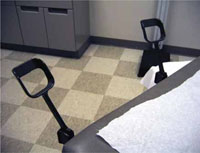The annual pelvic examination has been in the spotlight lately. After a commentary questioning its value was published early this year in the Journal of Women’s Health, the Wall Street Journal highlighted the controversy in its own high-profile article.1,2
At issue is a simple question: Does the pelvic examination deter women from seeking gynecologic care?
Some argue that the exam is so unpleasant that many women avoid their doctor’s office rather than undergo it. Here is the Wall Street Journal’s take on the issue. It’s the first line of its article on the subject:
Of all the indignities that women endure in their lives, one of the most dreaded is the routine pelvic exam.
The authors of the original commentary in the Journal of Women’s Health are a bit more circumspect. Carolyn L. Westhoff, MD, MSc, and colleagues discuss the reasons that a pelvic examination is traditionally performed—to detect sexually transmitted disease, clear a woman for contraception, and screen for cancer—and present evidence suggesting that these indications for the pelvic exam are no longer absolute in asymptomatic women.1
For example, Chlamydia can be identified in a culture obtained from urine or on vaginal swabs collected by the patient herself. Birth control pills can be prescribed without examining the patient as long as she is in good health and reports no problems. And evidence suggests that the pelvic exam—including bimanual palpation—does not increase the detection of ovarian cancer in asymptomatic women.
And now that ACOG has raised the minimum age for cervical cancer screening to 21 years and extended intervals between Pap tests for women who have normal results, there is no reason to examine the cervix every year, Dr. Westhoff and colleagues argue. In young women, annual inspection is unnecessary because cervical dysplasia tends to be transient, and, in older women, cervical inspection is unnecessary because a simple human papillomavirus (HPV) test can yield just as much information as a Pap smear and can be conducted on self-collected vaginal swabs.
So the question remains: Is the annual pelvic exam really required?
I would argue that the answer is “Yes.”
The pelvic examination offers many benefits
I find the pelvic exam to be indispensable in the assessment of the vulva, vagina, pelvic floor, and sexual function—and it yields information I often cannot obtain in any other way. For example, some vulvar lesions produce no symptoms but still pose a risk of cancer or represent a developing problem such as lichen sclerosis, but I cannot identify them unless I see them.
The physical examination of tissue also prompts me to ask focused questions, frequently about things the patient is too embarrassed to bring up herself. For example, I may examine a woman and find a cystocele or urethrocele. If she hasn’t mentioned leaking urine or other difficulties, the discovery prompts me to ask more specifically about these symptoms. When I do, I often uncover a significant source of distress that, for whatever reason, the patient did not report herself.
Other examples: On occasion, during the pelvic examination, I discover vaginismus. That finding prompts me to ask about painful sex. And sometimes a perimenopausal woman has dry vaginal tissue that is not bothersome…yet. By identifying this condition early, I can suggest interventions that prevent the dryness from becoming bothersome.
Validation is another benefit of the pelvic exam. For example, some younger women think they “look weird” or have something wrong with their body, and my reassurance that everything is totally normal can greatly ease their mind.

The power of ritual
In a New York Times article about the need to focus on the actual patient rather than simply the data in her chart, Abraham Verghese, MD, relates the story of an elderly patient whose daughter was resistant to his recommendations until she watched him perform a comprehensive physical exam.3 The medical team discussed the case afterward and concluded that “the daughter witnessing the examination of the patient, that ritual, was the key to earning both their trusts.”3
“I find that patients from almost any culture have deep expectations of a ritual when a doctor sees them,” Dr. Verghese writes, “and they are quick to perceive when he or she gives those procedures short shrift by, say, placing the stethoscope on top of the gown instead of the skin, doing a cursory prod of the belly and wrapping up in 30 seconds.”3
I agree. Patients can be very resistant to our recommendations if they feel they have gotten substandard evaluation. And part of their expectation of evaluation is a physical examination. There is a sense of connection and closeness that patients have come to count on. And they can tell when we are not placing enough emphasis on this aspect of care.


